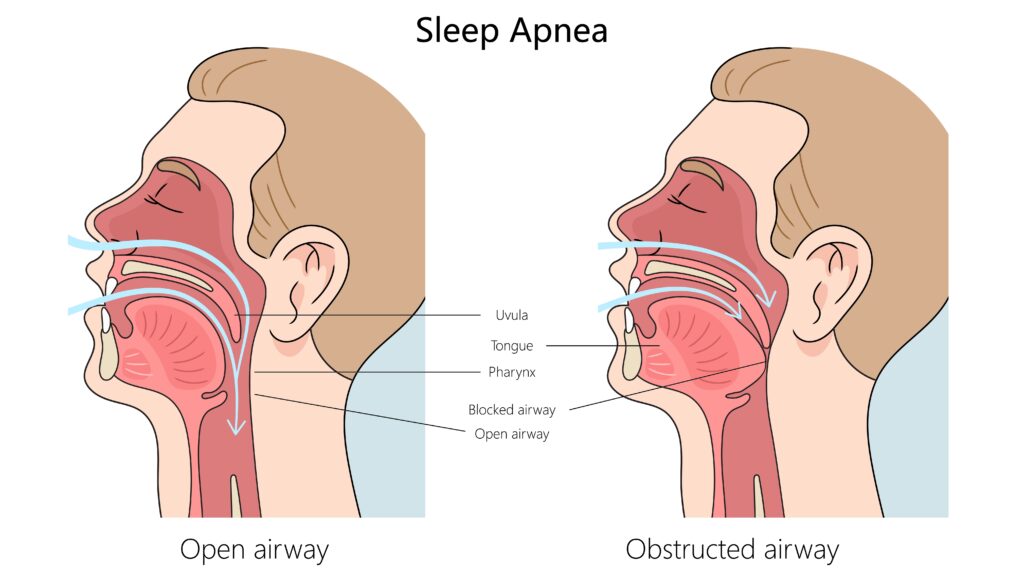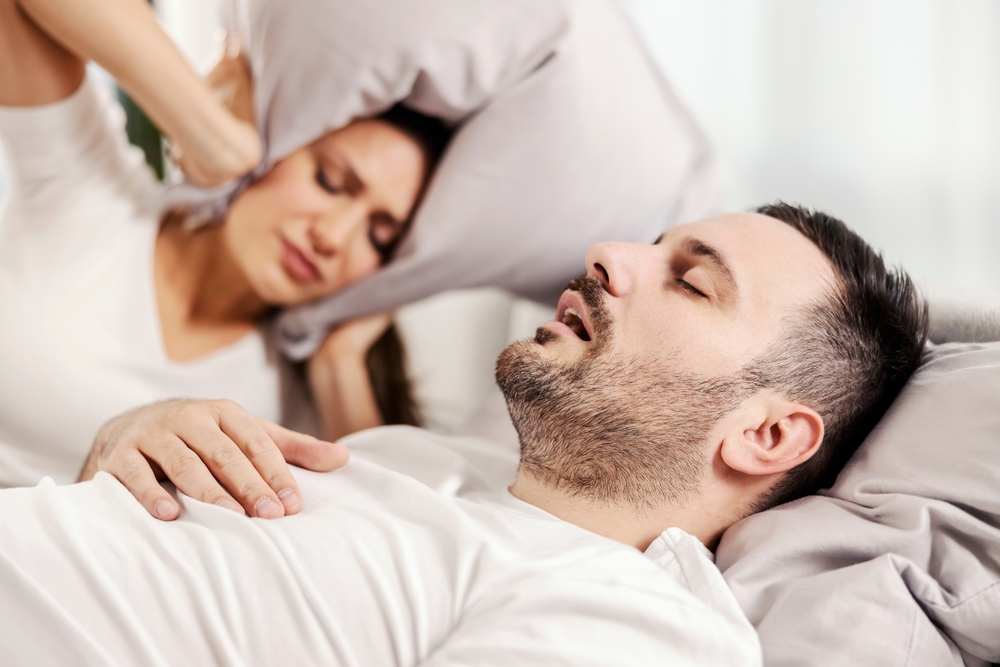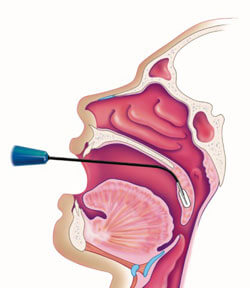Do you snore at night? Do you often find that you gasp or are startled awake in the middle of the night? These can be signs of a condition called sleep apnea.
Sleep apnea can impact your ability to sleep well and affect your health. The ENT specialists at Maryland ENT can diagnose and treat sleep apnea to help you sleep better and live a more fulfilling life.
What is Sleep Apnea?

Sleep apnea is a sleep disorder that causes you to stop breathing during sleep temporarily. These repeated pauses in breathing may last only seconds or minutes.
They can occur repeatedly throughout the night and disrupt your usual sleep pattern. Sleep apnea is a severe health condition that requires treatment and can lead to health complications like heart disease, stroke, diabetes, and high blood pressure without treatment.
There are three kinds of sleep apnea, including:
Central Sleep Apnea (CSA)
Central sleep apnea is a sleep disorder in which a person experiences temporary lapses in breathing because of abnormal brain activity. Central sleep apnea occurs when the brain slows or stops sending signals to the breathing muscles during sleep, resulting in long pauses between breaths.
A person with central sleep apnea may not appear to be attempting to breathe during sleep apnea events. If you have central sleep apnea, you will likely have normal anatomy, with nothing preventing or obstructing breathing.
Obstructive Sleep Apnea (OSA)
Obstructive sleep apnea occurs when the anatomy of the mouth or throat prevents normal breathing during sleep. When people sleep, their muscles relax.
When the muscles inside the mouth and throat (such as the “uvula”) relax, they can get in the way of normal breathing and block airflow. If you have obstructive sleep apnea, it will appear that you are attempting to breathe while sleeping. Sleeping may seem like it takes a lot of effort or involves loud snoring or grunting.
Mixed Sleep Apnea
If you have mixed sleep apnea, you’ll have both central sleep apnea and obstructive sleep apnea.
What Causes Sleep Apnea?
Central sleep apnea (CSA) is caused by problems that impact the brain, such as Cheyne-Stokes breathing, stroke, heart disease, kidney failure, certain drugs, and extremely high altitudes. Sometimes, CSA is labeled as idiopathic, meaning no known cause exists.
Obstructive sleep apnea (OSA) is caused by temporarily relaxing muscles during sleep. In some individuals, when the muscles relax, they relax too much and block the airway. This blockage makes breathing difficult or impossible.
Mixed sleep apnea often occurs when there is both central sleep apnea and obstructive sleep apnea.
Sleep Apnea and Snoring

Sleep apnea is a significant problem; it is dangerous for a body to be deprived of oxygen, even temporarily. When there is an apnea or temporary pause in breathing, your body rouses you from sleep to get you to start breathing again.
This wake-up is usually so brief that most people don’t remember it. For people with sleep apnea, these pauses in breathing and the brief wake-up that follows can occur up to 200 times per night, leading to extremely poor sleep quality.
Many people with sleep apnea are chronically tired, have difficulty focusing, may have memory problems, or find themselves becoming irritable. Snoring occurs when a person tries to breathe in their sleep, but tissue from their mouth or throat is in the way. The airflow from the respiratory system vibrates against the tissue, causing the snoring sound.
(Try it out right now; make a pretend snoring sound. Can you feel your soft palate or uvula moving in the back of your throat?
Or do you feel the airflow tickling the back of your nose and throat? That’s what happens during snoring. Imagine that you snored even harder, and the uvula collapsed in and blocked the airflow in your throat: that’s what happens in an obstructive sleep apnea event.)
Symptoms of Sleep Apnea
The best way to diagnose sleep apnea and discern its type is to have a sleep study. However, if you suspect you have sleep apnea, you may notice some of the following symptoms:
- Snoring
- Waking up choking or gasping for breathing
- Your partner noticing pauses in your breathing when you sleep
- Excessive fatigue during the day
- Morning headaches
- Morning dry mouth or sore throat
- Trouble paying attention during the day
- Memory difficulties
- Mood changes (like increased irritability, depression, apathy, etc.)
- High blood pressure
Diagnosing Sleep Apnea
Our ENT specialists at Maryland ENT may evaluate you for sleep apnea by asking questions about your symptoms and medical history. Weight, blood pressure, and heart rate are significant when diagnosing sleep apnea.
Our ENT specialists will also complete a physical exam of your nose, mouth, and throat and possibly recommend a sleep study. A sleep study is most often conducted at a clinic or hospital.
However, a home sleep study may be possible. In this study, the sleep apnea testing kit can be sent home with you to monitor your breathing while you sleep.
Treatment Options for Sleep Apnea
Treating sleep apnea is a crucial way of managing your symptoms. Treatment options may include:
Lifestyle Changes
Changing your sleep position, losing weight, using decongestants and nasal sprays, and other lifestyle changes may benefit patients with obstructive sleep apnea.
CPAP and BiPAP Machines
CPAP and BiPAP machines provide air pressure through equipment that fits into your nose or is placed over your nose and mouth while you sleep. This method is highly effective at reducing the number of times you stop breathing while you sleep and improving your overall quality of sleep.
Continuous positive airway pressure, or CPAP, provides constant airflow with slightly more pressure than the room air. The pressure keeps your upper airway passages open, preventing pauses in breathing and snoring.
Bilevel positive airway pressure (BPAP) provides a predetermined amount of air pressure when you breathe in and a different amount of pressure when you breathe out. Unlike CPAP, it is not constant.
Inspire Therapy
Inspire is a device that is surgically implanted into the chest and neck. The procedure is minimally invasive, and this method has a high success rate and low risk compared to airway reconstructive surgery.
The Inspire device stimulates the nerves and muscles under the tongue and throat, which are responsible for sleep breathing.

Coblation
Coblation is the controlled removal of tissues such as the tonsils, adenoids, and excessive parts of the soft palate or tongue using a radiofrequency device to open up the airway and decrease symptoms of sleep apnea. It’s an in-office procedure that can be completed in less than 10 minutes.
Are you ready to get relief from sleep apnea? Take the first step by requesting your appointment today at Maryland ENT in Lutherville and Baltimore, MD!



